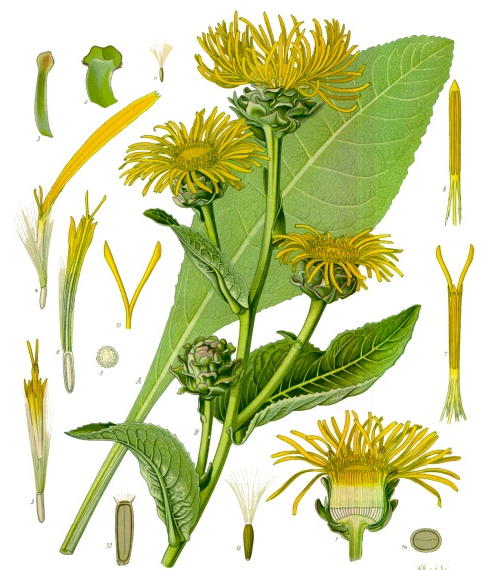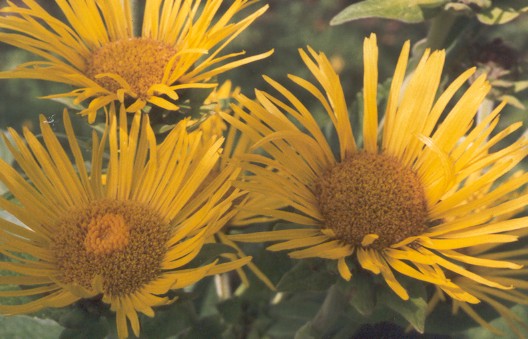
Inula helenium (L)
 Synonyms and Common names: Helenium grandiflorum (Gilib.), Aster
officinalis (All.), Aster helenium (L.), Alant, Elfwort, Elf Dock,
Velvet dock, Scabwort, Yellow starwort, wild sunflower, Elecampagne, Horseheal,
Horse elder
Synonyms and Common names: Helenium grandiflorum (Gilib.), Aster
officinalis (All.), Aster helenium (L.), Alant, Elfwort, Elf Dock,
Velvet dock, Scabwort, Yellow starwort, wild sunflower, Elecampagne, Horseheal,
Horse elder
German = Alant, French = Inule, Italian = Enula elemie
Order: Compositae
Description: Elecampane is a large herbaceous perennial, indigenous to south-eastern Europe and western Asia but naturalised in Britain, Ireland and the north mid-west US. It has a thick, cylindrical, branched rhizome and an erect, sparsely branched, tough, furrowed stem, hairy in the lower part and downy above. The oval basal leaves narrow into a winged petiole, pointed at the tip and blunt-toothed at the edges. The alternate stem leaves are irregularly toothed at the margin, large, tapering-oval in shape with a heart-shaped base, sessile and short-tapered. The single flowerheads grow at the ends of the branches from the axils of the leaves or bracts, and are sometimes arranged in sparse umbels. The outer, inwardly-turned bracts are oval and felty on the outside with a large heart-shaped green appendix which bends backwards. The inner bracts are lineate, dry membranous, and widened towards the ends. The bright yellow strap-shaped ray florets are numerous and about twice the length of the bracts. Both these and the inner disc florets are tubular. The plant flowers between June and October and grows wild in hedgerows and damp meadows; it is also cultivated.
Parts used: dried roots and rhizome
Collection: The rhizomes should be collected from plants which are at least two years old in September or October, after the stem has died back. If the flowers are cut off in the summer, the rhizomes will be allowed to develop.

Constituents: Sesquiterpene lactones (mainly alantolactone, isoalantolactone), triterpenoid saponins, sterols (sitosterol, stigmasterol), volatile oil (helenin, including camphor, alantol, alantoic acid, alantolactone), a thymol derivative, bitter principles (possibly including dammaradienol, stigmasterol, friedlin), possible alkaloid, inulin (up to 44% in autumn and 20% in spring), resin, pectin, mucilage. On steam distillation it yields 1-3% of a crystalline mass (helenin) with a little oil containing alantol.
Actions: Stimulating expectorant, antitussive, sedative, anthelmintic, diaphoretic, stomachic, bactericidal, antifungal, antiparasitic, relaxant, warming, tonic, alterative, diuretic
Indications: Bronchial or tracheal catarrh, cough of pulmonary tuberculosis, irritating cough in children. Specifically indicated in the irritating cough of bronchitis, especially in children.
Therapeutics and Pharmacology: Inula may be used in any respiratory condition which produces copious catarrh, such as bronchitis and emphysema and it was traditionally used to treat the cough of pulmonary tuberculosis. Research has shown that the volatile oil is active against the tubercle bacillus. The volatile oil has a stimulating effect on the mucociliary escalator and the circulation, while the saponins stimulate the bronchial structures by reflex from their detergent irritant effect on the stomach wall. This results in an increase in the active elimination of mucus from the lungs. The soothing mucilages help to mitigate what might otherwise be fairly harsh effects. Alantolactone and other related compounds have expectorant, secretolytic and antitussive activity; and have demonstrated antibacterial and antifungal actions too. Alantolactone has been used as an anthelmintic in the treatment of roundworm, threadworm, hookworm and whipworm infestation, and has exhibited anti-inflammatory and hypotensive properties in animals.
Inula is of particular benefit in the treatment of chronic bronchitis in the elderly and congestive complaints in children. It is an appreciable relaxant so is also indicated when there is a nervous component in a cough. The plant�s bitter tonic properties stimulate the appetite and digestion, increasing the flow of bile, and can be used to support a debilitated constitution, particularly following influenza or bronchitis. It promotes menstruation and is used to treat anaemia. Externally, it may be used in the treatment of scabies, herpes and other skin diseases from which it gained its common name scabwort.
Combinations: Inula combines well with Marrubium, Tussilago, Asclepias and Achillea in the treatment of respiratory problems.
Caution: Occasional allergic reactions may occur. Inula should not be used during pregnancy or lactation.
Preparation and Dosage: (thrice daily)
GSL Schedule 1
Dried root: 1.5-3g or by decoction
Liquid Extract: 1:1 in 25% alcohol, 1-2ml
Tincture: 1:5 in 25% alcohol, 3-5ml
Additional Comments: The name Inula comes from Helen of Troy, from whose tears it is said to have sprung. The Greeks and Romans, regarded elecampane as a cure-all for ailments as diverse as dropsy, digestive upsets, menstrual disorders and sciatica. The Anglo-Saxons used the herb as a tonic and as a treatment for skin disease and leprosy. By the 19th century it was being used to treat skin disease, neuralgia, liver problems and coughs. Inulin was first isolated from elecampane in 1804 and took its name from the herb. Chinese research has demonstrated mild antibacterial properties as well as a stimulant effect on the nervous system, digestion and adrenal cortex.
In China, the flowers of Inula japonica are used to treat asthma and bronchitis with excessive phlegm, and for vomiting and acid reflux. Inula racemosa has been reported to prevent ST-segment depression and T-wave inversion in patients with ischaemic heart disease, and to have a beneficial effect on angina pectoris.
Elecampane is used to flavour digestive liqueurs and vermouths and is candied and used in confectionery. It is often added to proprietary cough linctuses, pastilles and pills.
Bibliography
Bartram, T. 1995 Encyclopedia of Herbal Medicine, 1st edn.,Grace Publishers, Bournemouth.
Bradley, P.R. (ed.) 1992 British Herbal Compendium, Volume 1, BHMA, Bournemouth.
Bremness, L. 1994 Herbs, Dorling Kindersley Eyewitness Handbook, London.
BHMA 1983 British Herbal Pharmacopoeia, BHMA, Bournemouth.
Chevallier, A. 1996 The Encyclopedia of Medicinal Plants, Dorling Kindersley, London.
Grieve, M. 1931 A Modern Herbal, (ed. C.F. Leyel 1985), London.
Hoffmann, D. 1990 The New Holistic Herbal, Second Edition, Element, Shaftesbury.
Lust, J. 1990 The Herb Book, Bantam, London.
Mabey, R. (ed.) 1991 The Complete New Herbal, Penguin, London.
Mills, S.Y. 1993 The Essential Book of Herbal Medicine, Penguin, London (First published in 1991 as Out of the Earth, Arkana)
Mills, S.Y. 1993 The A-Z of Modern Herbalism, Diamond Books, London.
Newall, C.A., Anderson, L.A., & Phillipson, J.D. 1996 Herbal Medicines: A Guide for Health-care Professionals, The Pharmaceutical Press, London.
Ody, P. 1993 The Herb Society's Complete Medicinal Herbal, Dorling Kindersley, London.
Polunin, M. and Robbins, C. 1992 The Natural Pharmacy, Dorling Kindersley, London.
Prihoda, A. 1989 The Healing Powers of Nature, Octopus, London.
Weiss, R.F. 1991 Herbal Medicine, Beaconsfield Arcanum, Beaconsfield.
Wren, R.C. 1988 Potter's New Cyclopaedia of Botanical Drugs and Preparations, C.W.Daniel, Saffron Walden.










